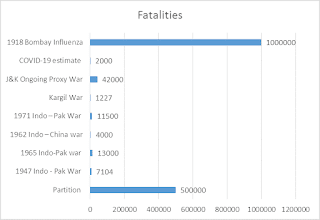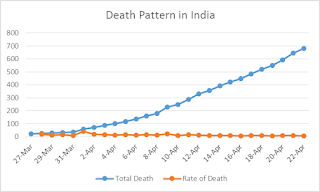Are there Parallels
1. As per reports about the Bombay Influenza also called globally as Spanish flu came to India via the Mumbai Port. Seven police Sepoy at the Bombay docks were the first to get infected. Entire Mumbai thereafter got infected with the flu. It is believed that globally
somewhere between 50 – 100 million lives were lost. India too suffered between 10 to 20 million. If one were to take the mean of the two values around 1.5 crore people would have died in India itself. The flue came in two waves. In the first wave it only affected the old and the children. The spread was initially restricted around the Bombay area but later engulfed the entire country like a wild fire. Interestingly in the second wave the disease was extremely harsh on people between 20 – 40 years of age.
2. Pandemics are as deadly as war if not more as the graph above suggests. Some interesting questions arise from the above pattern what would have been the impact of COVID-19 if lockdowns had not been imposed in time? We must thank the government for such a wise and timely decision. This time round too, the disease has infected maximum people from Maharashtra and around because then entire Gujarat was part of Bombay presidency. If we add up the figures of Gujarat and Maharashtra the total affected cases as on today comes to 9064. This is almost half the numbers of entire country. Even in 1918 the flue first affected the elderly. This time too, the pattern is same. In the second wave it affected people in the ages of 20 to 40. Are we going to see a repeat? My guess is yes. The reason is obvious, currently while the elderly, sick and the children are locked up the young and healthy are out in the open exposed to the dangers of COVID -19 delivering essentials, young security personnel, and fruit / vegetable / milk .If the opening of the lock down is not managed properly we may see the disease spreading like wild fire. Another factor to worry are the states of UP and Bihar. Currently the workers from these states are struck in Maharashtra and Delhi. Moment they are allowed to go to their home states and if the home states do not screen and manage them properly we will see a second explosion of COVID -19 in India.
Possible Way Ahead
3. Are we prepared for it? I am sure the governments are looking into it and will not allow such a situation from occurring. The battle ground is going to shift from Maharashtra and Delhi tot UP and Bihar. The earlier we take preventive action the better it would be for the country. Given the concentration of population in Bihar and UP it will take matter of days to become the epicenter of COVID-19.
4. Controlled Opening of the Lockdown. My suggestion would be to open up the lockdown in an extremely controlled manner as and when the government considers to do so. The movement of migrants must take place in a controlled manner in special trains before opening railway traffic to the common public. Migrants must be properly screened and segregated on arrival as per their health status and only negative cases allowed to proceed to their homes. Proper food and medical facilities must be provided to the migrant workers during the transit till they reach their homes.
5. Case for Epidemic Management Territorial Army (EMTA) Units. The lesson is clear, pandemic needs war like management. It is as lethal if not more as any wars that independent India has fought. We have raised NDRF battalions for disaster response. However, their numbers are low. Can we not think of Epidemic Territorial Army Battalions to deal with such contingencies whenever they arise? Even in the current crisis though we seem to be flattening the death graph is still increasing linearly and over time will mount. And if UP, Bihar and Bengal explode the consequences are unimaginable. It will be worth examining the option of raising EMTA units on the lines of Environment TA units. They could be manned with a nucleus manpower during normal times and activated in crisis like COVID-19, SARS and H1N1 flue etc. This would also not entail much expenditure as these units would be manned by only a nucleus staff and minimum essential equipment for immediate response. Rest of the personnel and equipment would be mobilized on imminence of occurrence / occurrence. These units will also be able to augment the existing disaster management units of NDRF which are well short of numbers in managing pandemics and mega disasters either man made or natural. EMTA units should have medics and paramedics, technical personnel such as electricians, communications, engineering, tradesmen, drivers’ combatants, for administration and security of makeshift quarantine camps and combatants for augmentation of police resources for access control. Ex-Servicemen can very easily staff these units on the lines of existing DSC units. More importantly it will free up the Armed Forces from being involved in managing natural calamities or CBRN disasters.

